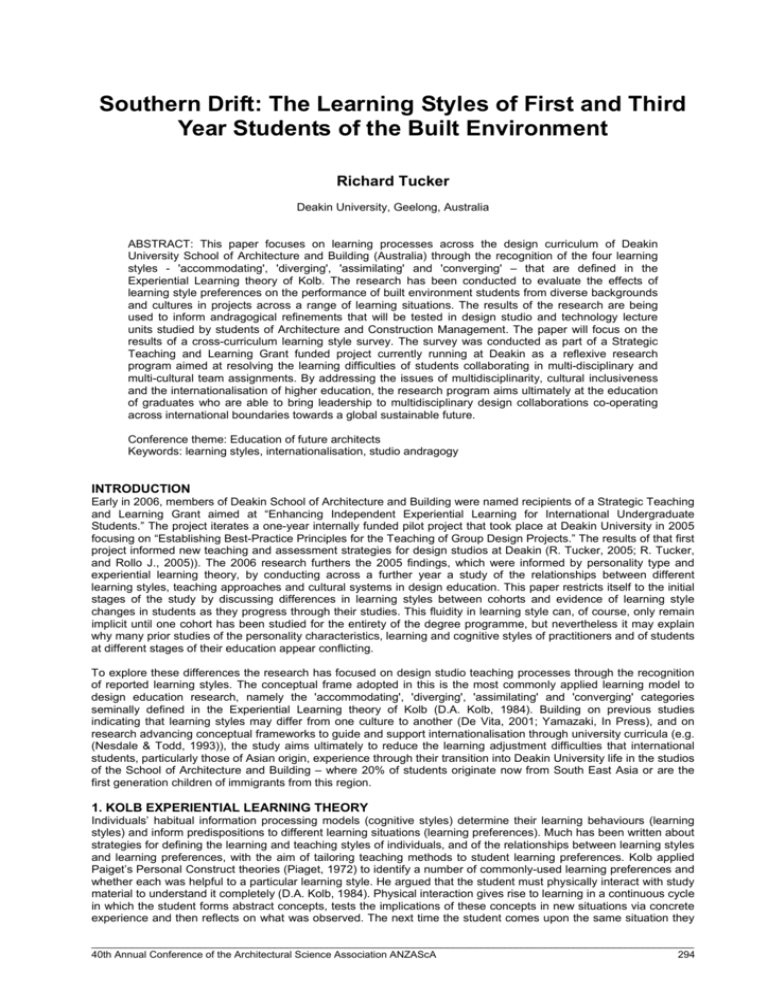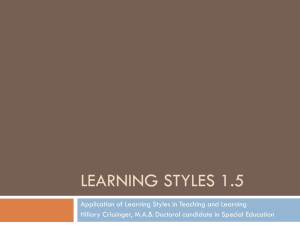Southern Drift: The Learning Styles of First and Third Year Students
advertisement

Southern Drift: The Learning Styles of First and Third Year Students of the Built Environment Richard Tucker Deakin University, Geelong, Australia ABSTRACT: This paper focuses on learning processes across the design curriculum of Deakin University School of Architecture and Building (Australia) through the recognition of the four learning styles - 'accommodating', 'diverging', 'assimilating' and 'converging' – that are defined in the Experiential Learning theory of Kolb. The research has been conducted to evaluate the effects of learning style preferences on the performance of built environment students from diverse backgrounds and cultures in projects across a range of learning situations. The results of the research are being used to inform andragogical refinements that will be tested in design studio and technology lecture units studied by students of Architecture and Construction Management. The paper will focus on the results of a cross-curriculum learning style survey. The survey was conducted as part of a Strategic Teaching and Learning Grant funded project currently running at Deakin as a reflexive research program aimed at resolving the learning difficulties of students collaborating in multi-disciplinary and multi-cultural team assignments. By addressing the issues of multidisciplinarity, cultural inclusiveness and the internationalisation of higher education, the research program aims ultimately at the education of graduates who are able to bring leadership to multidisciplinary design collaborations co-operating across international boundaries towards a global sustainable future. Conference theme: Education of future architects Keywords: learning styles, internationalisation, studio andragogy INTRODUCTION Early in 2006, members of Deakin School of Architecture and Building were named recipients of a Strategic Teaching and Learning Grant aimed at “Enhancing Independent Experiential Learning for International Undergraduate Students.” The project iterates a one-year internally funded pilot project that took place at Deakin University in 2005 focusing on “Establishing Best-Practice Principles for the Teaching of Group Design Projects.” The results of that first project informed new teaching and assessment strategies for design studios at Deakin (R. Tucker, 2005; R. Tucker, and Rollo J., 2005)). The 2006 research furthers the 2005 findings, which were informed by personality type and experiential learning theory, by conducting across a further year a study of the relationships between different learning styles, teaching approaches and cultural systems in design education. This paper restricts itself to the initial stages of the study by discussing differences in learning styles between cohorts and evidence of learning style changes in students as they progress through their studies. This fluidity in learning style can, of course, only remain implicit until one cohort has been studied for the entirety of the degree programme, but nevertheless it may explain why many prior studies of the personality characteristics, learning and cognitive styles of practitioners and of students at different stages of their education appear conflicting. To explore these differences the research has focused on design studio teaching processes through the recognition of reported learning styles. The conceptual frame adopted in this is the most commonly applied learning model to design education research, namely the 'accommodating', 'diverging', 'assimilating' and 'converging' categories seminally defined in the Experiential Learning theory of Kolb (D.A. Kolb, 1984). Building on previous studies indicating that learning styles may differ from one culture to another (De Vita, 2001; Yamazaki, In Press), and on research advancing conceptual frameworks to guide and support internationalisation through university curricula (e.g. (Nesdale & Todd, 1993)), the study aims ultimately to reduce the learning adjustment difficulties that international students, particularly those of Asian origin, experience through their transition into Deakin University life in the studios of the School of Architecture and Building – where 20% of students originate now from South East Asia or are the first generation children of immigrants from this region. 1. KOLB EXPERIENTIAL LEARNING THEORY Individuals’ habitual information processing models (cognitive styles) determine their learning behaviours (learning styles) and inform predispositions to different learning situations (learning preferences). Much has been written about strategies for defining the learning and teaching styles of individuals, and of the relationships between learning styles and learning preferences, with the aim of tailoring teaching methods to student learning preferences. Kolb applied Paiget’s Personal Construct theories (Piaget, 1972) to identify a number of commonly-used learning preferences and whether each was helpful to a particular learning style. He argued that the student must physically interact with study material to understand it completely (D.A. Kolb, 1984). Physical interaction gives rise to learning in a continuous cycle in which the student forms abstract concepts, tests the implications of these concepts in new situations via concrete experience and then reflects on what was observed. The next time the student comes upon the same situation they _________________________________________________________________________________________________________ 40th Annual Conference of the Architectural Science Association ANZAScA 294 will utilise the knowledge base gained during the first cycle to move on to more complex experiences. The cycle described by Kolb is one that would be familiar to design students, for it echoes the iterative process of reading, questioning, testing, and reformulating that is characteristic of design progression in studio assignments. Kolb suggested that experiential learning strategies should be adopted throughout education with teaching models that help students move round the learning cycle to achieve ‘deep’ learning. Although architectural education has yet to explicitly acknowledge the Kolb cycle as an andragogical theory that underpins its teaching frameworks, it is clear, as Webster points out, that design teaching promotes experiential learning in much the same way as other fields of professional education (Webster, 2001). It is fitting, therefore, that Kolb’s model has been utilised most commonly by researchers evaluating the learning styles of design students. In order to draw on and evaluate this prior research, it was decided in the Deakin study to utilise the Kolb model and its testing instrument the Learning Style Inventory (LSI). 2. LEARNING STYLE RESEARCH IN DESIGN EDUCATION Much has also been written about learning differences among tertiary students (Dunn & Dunn, 1975) and how these differences might inform teaching, but only a few studies have been applied to design or architectural education. Newland et al. (1987) researched the relationships between the learning styles, perception and cultural bias of architects using Kolb’s learning theory as a basis for testing. The Newland study stated support for using Kolb in the work of Powell et al. (J A. Powell, Cooper, & Lera, 1984), who had previously used the LSI to test undergraduate architectural students. In Newland’s study four types of designers were identified in relation to learning styles: common sense learners, dynamic learners, contemplative learners, and zealous learners. Newland et al. concluded that architects' learning styles are slightly biased towards the upper left (North West) of the Kolb typology (borrowing Talbot’s (1982) visually descriptive presentation of the Kolb scores that refers to the spatial location of styles in the two-dimensional LSI cycle) – i.e. learners Kolb would term as 'accommodators.' Others have employed the Myers-Briggs-type indicator (MBTI), based on Jung’s (1921) psychological types, to identify the personality profiles of designers ((McCaulley, 1990) (Brown, Hallett, & Stoltz, 1994)). Brown et al. found the dominant profiles in landscape architecture students to be intuitive-thinking and intuitive-feeling types. Lawson (1993) also observed that architecture students tended to adopt more intuitive approaches when engaging with problem solving. Durling et al. (1996) reported a personality survey of art-based design students also using the MBTI and reported that it was possible to discriminate designers both from a normal population and from cognate professionals. Durling et al. conclude that designers largely prefer teaching that begins with the exploration of concepts before explaining details, is loosely structured to allow for guided exploration, and is logical and analytical of objective data and is based on the knowledge of exemplars – a list of teaching preferences that accurately describes studio models common to architectural education in the U.K. A third of the designers tested in Durling’s sample preferred, however, more subjectivity, a person-centred approach, and value judgements, which confirms the findings of other studies - namely that no single kind of design learning is suitable for all designers. More recently, Demirbas and Demirkan (2003) and then Kvan and Yunyan (2005) related the design process undertaken by student architects to Kolb’s learning cycle (D.A. Kolb, 1984). Demirbas and Demirkan found that in their sample of first year students significantly fewer learners preferred the accommodating style to other learning styles; and that most students (65%) were assimilators and convergers. Demirbas and Demirkan also showed statistically significant differences between the performances of students with different learning styles at different stages of the design process. The results too of Kvan and Yunyan (2005) demonstrated a significant correlation between learning style and students’ academic performance in design studios. Their study suggested that a learning style test conducted in the early phase of design studio, and teacher awareness of the need to accommodate diverse learning styles, might inform changes in studio programs. When discussing fourteen factors that contribute to excellence in studio teaching in architecture, Attoe and Mugerauer (1991) also highlight the importance of customising teaching methods to students’ learning styles. Singhasiri et al. (2004) investigated the learning styles of first year architecture students in Thailand in order to see if the curriculum and materials catered for these styles, and found that most first year architects were concrete learners – i.e. accommodators and divergers . In 2006, Roberts (2006) considered the relationship between cognitive styles and student progression in architectural design education. In contrast to what Robert’s review of the literature suggested, namely that students with a tendency to think holistically may have an advantage in learning to become architects over more analytic students, Roberts results suggested the reverse of this hypothesis, namely that students categorised as ‘analytic’ performed better than the other groups, especially in the early stages of their architectural education. The study concluded that “although analytic students appear to have an advantage in their early years, by the time they graduate cognitive style may have little effect upon their performance in design project work” (Roberts, 2006: 179). The research presented in this paper investigates the learning styles of 152 undergraduates at Deakin. It evaluates and compares the different learning styles of students from two year groups - first and third-year - enrolled in three undergraduate courses; Bachelor of Arts (Architecture), Bachelor of Construction Management, and a double degree Bachelor of Architecture/Construction Management. Learning style preferences were gathered through the Kolb LSI (D.A. Kolb, 1984). Using this instrument, two questions were considered. Firstly, are there marked differences between the learning style profiles of the three degree programs? And secondly, are there marked differences between the learning style profiles of the first and third year cohorts that may suggest evidence of fluid learning styles and, consequently, the ability to change learning styles through teaching. _________________________________________________________________________________________________________ 40th Annual Conference of the Architectural Science Association ANZAScA 295 3. LEARNING STYLE INVENTORY - METHODOLOGY 3.1 Participants and Materials All first and third year architecture and CM students enrolled in 2006 were asked in their first lectures to volunteer to complete a questionnaire and learning style inventory. Procedures governing the recruitment of students, their briefing and questioning, and the collection and storage of data where approved by the Deakin University Human Research Ethics Committee (EC 78-2006). 104 first year students and 48 third year students participated in the study. Of the first years, 27 were CM students, 52 were architecture students and 25 students were enrolled in a combined architecture/CM double degree. 63 (60.6%) of the students were male and 41 (39.4%) were female. First year participants ages ranged from 17 to 25, with the majority of students aged between 17 and 20 (90.4%) and the remaining 10 students (9.6%) in the 21 to 25 age range bracket. Of the third year students, 29 were studying architecture and 19 were enrolled in the double degree. The third year cohort contained 27 males (56.3%) and 21 females (43.8%). Again, the students’ ages ranged in third year between 17 and 25, with 23 students (47.9%) aged between 17 and 20 whilst 25 (52.1%) students were between 21 and 25. The Learning Style Inventory (LSI) was first developed by Kolb in 1971 (LSI 1) and revised later in 1985 (LSI 2), in 1993 (LSI 2a), in 1999 (LSI 3) and again in 2005 (LSI 3a). In this study, LSI 2 was utilised due to its free availability. 3.2 Procedure There are twelve open-ended questions that have four different responses in the LSI. Each question asks respondents to rank four sentence endings to best describe their learning preference. After answering the questions, four scores are calculated using the test key. These scores are clustered under four modes of the learning cycle as CE (concrete experience), RO (reflective observation), AC (abstract conceptualisation), and AE (active experience). In the next stage, by subtracting CE from AC and RO from AE scores, two combined scores are determined that show the position of the individual learner in the two bipolar scales. The two scores refer to the different ways by which students learn: the first (AC–CE) is how a student perceives’ new information or experience, and the second (AE–RO) is how a student processes what is perceived. In other words, the combined score indicates the learning style preference of that individual. As is normal practice in the Kolb model (1985), the axes that distinguish the learning spaces of the four learning styles has been shifted in this study from the zero, zero point to an empirical norm (AC-CE=3,4; AE-RO=5,6). 4. RESULTS In the Deakin sample, learning style inventories were taken to give the learning style profiles of what have been broken down into eight cohorts. Three of these are shown on the Kolb learning style graphs illustrated in figures 1 and 2. The eight cohorts are: 1) the entire sample (Accommodators [Acc] 18.6%, Divergers [D] 17.9%, Assimilators [Ass] 32.1%); Convergers [C] 31.4%; 2) first-years (Acc 21.3%, D 19.4.3%, Ass 28.7.3%, C 30.6%); 3) third years (Acc 12.5%, D 14.6%, Ass 39.6%, C 33.3%); 4) first year architects (Acc 19.6%, D 14.3%, Ass 32.1%, C 33.9%); 5) third year architects (Acc 17.9%, D 14.3.6%, Ass 39.3%, C 28.6%); 6) architects (first and third years combined) (Acc 19.0%, D 14.3%, Ass 34.5%, C 34.2%); 7) double degree architecture/CM students (combined) (Acc 18.1%, D 20.4%, Ass 29.6%, C 31.9%); 8) construction managers (first years only) (Acc 14.8%, D 25.9%, Ass 29.6%, C 29.6%). Source: (Author 2006) Figure 1: Graph showing Kolb Learning Style Distributions st rd of the entire sample of 1 and 3 years combined. Kolb and Wolfe (1981) suggest that there are disciplinary differences in learning styles and that the dominant style in architects is accommodator (highly inclined to doing and slightly inclined to feeling). This latter finding is in contrast to the studies of Demirbas and Demirkan (2003) and Kvan and Yunyan (2005) who found accommodators in the minority for architecture students. Our findings are far closer to these latter two studies than to Kolb and Wolfe’s, for accommodator was the least common learning style in third year architects at Deakin and the second least in the sample as a whole and in first year architects. Assimilators and convergers, each at around 34% of the entire cohort of architects, were the most common type. This is consistent again with Demirbas and Demirkan’s sample in which 31.8% of freshman architects were assimilating and 33% converging. As can be seen from Figure 2, perhaps the _________________________________________________________________________________________________________ 40th Annual Conference of the Architectural Science Association ANZAScA 296 most noticeable difference in learning styles is not between disciplines but rather between year cohorts, because the diverse distribution of styles seen in first year is in contrast to the distribution seen in third year, which is heavily loaded to converging and assimilating learning. The reasons for this will be considered in section 4.3 of this paper. 1 2 Source: (Author 2006) Figure 2: Graphs showing Kolb Learning Style Distributions of two 2006 cohorts; 1) all first-years, 2) all third years. 4.1. Data Screening and Analysis A number of analyses of variance were conducted with the AC-CE and AE-RO dimensions of the LSI as dependent variables, and with discipline, gender, age, and enrolment year as the independent variables. It should be noted that with the increased number of analyses of variance the probability of a Type 1 error increases. To correct for this increased error rate a corrected Bonferroni adjusted alpha (alpha (.05) / n (number of comparisons = 14) level of .003 could have been utilised. However, as it is the aim of this paper to provide an overview of the pattern of results, and as the .003 alpha was considered to be too stringent for these exploratory aims, findings were interpreted at the 0.05 alpha significance level. Caution also needs to be excised with regards to the skewness of the distribution. When the distributions of AC-CE and AE-RO were examined for normality, one of the third year cases had to be excluded as it remained an extreme outlier on both the AC-CE and AE-RO dimensions. A number of other outliers were found, but their exclusion did not affect the outcomes of the analysis. The distribution of scores on the AE-RO dimension was negatively skewed (skew = - 0.281, SE skew = 0.19) but was non-significant at the 0.01 level (Kolmogorov-Smirnov .082, p < 0.014). The distribution of the AC-CE dimension was also slightly negatively skewed (skew = -.288, SE skew .197) but was non-significant at the .05 level (Kolmogorov-Smirnov .057, p < 0.200). Standard data transformations failed to improve the distribution. Since the value of skewness was small, the following analyses were conducted on untransformed data. Thus, caution needs to be exercised when interpreting the results of the analysis of AE-RO scores. 4.2. Differences between the Learning Styles of Three Built Environment Degree Programs Selecting only first years, differences were looked for in the learning styles of students according to their principal focus of study (table 1a). A one-way analysis of variance (with AC-CE and AE-RO as dependent variables and principal focus of study as the independent variable) confirmed that first years adopted similar learning styles irrespective of discipline (AC-CE: f (2,101) 1.223, p> 0.29; AE-RO: f(2, 101) 0.693, p> 0.503). The analysis was repeated for students in their third year of study (table 2). Results revealed there to be no significant difference between third year students studying architecture compared with third year students studying a combined degree on either the AE-RO dimension f(1, 46) .01p>.919, or the AC-CE dimension f(1,46) .086, p>.771. When learning style responses were combined for first and third year architecture and combined degree students (table 3), a one way analysis of variance revealed that there was no difference between all architecture students and all combined degree students on either the AE-RO dimension f(1, 122) .027 p>.869, or the AC-CE dimension f(1, 122) .413 p>.522. Table 1: a) First year Kolb LSI (II) Results. b) First and Third Year and Male and Female Kolb LSI (II) Results (AERO/ACCE). a) AERO ACCE b) Construction Management M SD 2.37 12.27 4.59 11.09 st 1 Year Architecture M 5.76 7.11 Combined f 2, 101 2, 101 .693 1.223 P SD 11.47 10.13 rd 3 Year M 4.68 3.48 SD 11.50 6.41 Df F P 1, 149 1, 149 .362 5.469 .548 .021 SD 12.55 9.52 Df F P 1, 149 1, 149 .847 .359 3.937 .049 Source: (Author 2006) Kolb AERO Kolb ACCE M 4.62 5.58 SD 12.14 10.31 Males M 3.36 9.40 Kolb AERO Kolb ACCE M 4.97 5.51 SD 11.47 9.52 M 3.16 8.58 SD 13.45 9.7 df .503 .299 Females _________________________________________________________________________________________________________ 40th Annual Conference of the Architectural Science Association ANZAScA 297 Previous studies have shown that student learning style distributions differ significantly within the specific area of specialisation of their choice as well as by academic fields (D. A. Kolb, 2000). These findings are congruent with Kolb’s assertion (D. A. Kolb & Wolfe, 1981) that individuals tend to choose academic fields and careers whose learning environment value and nurture their own style of learning. Although in the Deakin sample there was no statistically significant difference between Kolb learning styles across degree types, trends indicate that students studying architecture tended to report a smaller proportion of diverging learning styles than CM students. For whilst among architects (in both the first and third years ) the proportion of divergers was low at 14% (compared to the eclectic spread of learning styles expected in those studying a generalist field of study (Nulty & Barrett, 1996), the CM cohort was comprised of nearly twice as many divergers. Table 2: Third Year Kolb LSI (II) Results. AERO ACCE Architecture M SD 2.96 13.44 8.55 6.60 M 3.31 9.21 Combined SD 8.08 8.99 df 1, 46 1, 46 f .100 .086 p .919 .771 Source: (Author 2006) Table 3: First and Third Year Architecture and Combined Double Degree Kolb LSI (II) Results. AERO ACCE M 4.76 7.62 Architecture SD 12.20 9.01 M 4.39 6.53 Combined SD 11.30 9.04 df 1, 122 1, 122 f .027 .413 p .869 .522 Source: (Author 2006) 4.3. Southern Drift: The Differences between the Learning Styles of First and Third Year Architecture and Architecture/Construction Management Double Degree Students Kolb suggests that learning styles are shaped gradually by individual experience. Nulty and Barrett (1996) suggest that this change is the result of a gradual process of adaptation to learning demands and to the reward systems students experience. As these demands and rewards are likely to vary in different disciplines, then a student’s adaptation to them might be seen as a gradual induction into the academic culture of their chosen discipline. It follows that a generalist educational experience prior to university would result in a comparatively diverse approach to study, for high school students, in order to be successful, could not risk aligning themselves too strongly with the learning style of one particular discipline. In contrast, students' attention at university is likely, as Nulty and Barrett’s findings confirm, “to be focused more on an in-depth study of a narrower range of disciplines. The nature of this experience is more likely to present particular learning demands which were not apparent at the secondary school level” (Nulty & Barrett, 1996: 336). The suggestion in Nulty and Barrett’s study of fluidity in learning styles over time is borne out by Kvan and Yunyan (2005) who found that the proportion of accommodators increased from 16.2% in second year to 20.4% in third year. Table 4: First and Third Year Kolb LSI (II) Results. M Kolb Concrete Kolb Abstract Kolb Active Kolb Reflective 1st 26.16 31.12 33.54 29.25 SD 3rd 23.18 32.00 33.95 30.85 1st 6.78 6.64 6.93 6.96 rd df F 4.11 5.21 5.87 6.89 1, 154 1, 154 1, 154 1, 154 7.946 .646 .129 1.775 3 P .005 .423 .720 .185 Source: (Author 2006) Results (table 1b) revealed that third year students had significantly higher ratings on the dimension of AC-CE (M 9.40 SD 6.41) compared to first years (M 5.58 SD 10.31) f(1, 149) 5.469 p<.021. There was, unlike Kvan and Yunyan’s sample, no significant difference between first and third year ratings on the dimension of AE-RO f(1,149) .362 p>.548. However, as Levene’s test for homogeneity of variance was violated for the AC-CE dimension (1, 149) 8.982 p<.003, these results need to be interpreted with caution. Levene’s test was satisfied for the AE-RO dimension (1, 149) .014, p>.907. A one-way analysis of variance also examined the relationship between age and gender on the learning style dimensions of AE-RO and AC-CE. Although there was no significant interaction between age and learning dimension; AE-RO f(1,149) 1.216 p>.272 and ACCE f(1, 149) .069 p>.793, a significant effect was found for gender (table 1b). A one-way analysis of variance revealed that females (M 8.58, SD 9.05) had significantly higher ratings on the dimension of AC-CE (f(1, 149) 3.937, p <.049) compared to males (M 5.51, SD 9.52). No significant difference was found between males and females on the dimension of AE-RO f(1, 149) .847 p>.359. As homogeneity of variance was not violated for either dimension (AE-RO (1, 149) .469 p>.495; AC-CE (1, 149) .009 p>.952) the results for gender can be interpreted with confidence. Evidence for different learning styles in more senior students is confirmed in the Deakin sample by one-way analysis of variance (ANOVA), see table 4, which demonstrates that first year students (M 26.16, SD 6.78) had significantly higher scores on the Kolb concrete experience mode than the third year students (M 23.19, SD 4.11) f (1, 154) = 7.946, p<.005. As there was no significant difference between first and third years on any of the other Kolb learning style dimensions, this shift away from the concrete experience mode accounts for the significant increase in learners at third year whose style can be plotted below the AE-RO (x) axis on the Kolb distribution graph. Gender was revealed to have no significant main effect on Kolb learning styles f(1, 152) 1.452 p>.230, and no significant interaction effect with student year level f(1, 152) .011 p >.917. _________________________________________________________________________________________________________ 40th Annual Conference of the Architectural Science Association ANZAScA 298 Source: (Author 2006) Figure 3: Graphs showing Kolb Learning Style Means for 1st and 3rd years combined and for 1st and 3rd year Architecture and double degree students. The learning style drift is highlighted in the two graphs in figure 2, where the eclectic scatter of learning styles seen for all first years is replaced by a range that has predominantly shifted south for all third years towards converging and assimilating learning – styles termed by Abbey et al. (1985) as Southerner (the name corresponds to the spatial location of this ‘secondary’ (as Kolb refers to it) style in the two-dimensional LSI cycle). The analysis of variance results can be qualified by a chi square analysis examining the relationship between student year level and the southern and northern dimensions of the Kolb Learning cycle (see figure 4). Although not significant at the .05 alpha level, the analysis revealed there to be a move towards a significant trend in the data χ2(1, N = 151) 3.109, p>.07 towards Southerner learning in third year. Moreover, comparing percentages across year level for the dimensions of north and south in the Kolb learning cycle shows that for first year students there is a fairly even spread across the northern (40.4%) and southern dimensions (59.60%), while for the third year sample 74.5% of students were in the southern dimension and only 25.50% in the northern dimension. The southern drift from first to third year here is confirmed in figure 3, which illustrates movement south in the mean learning styles of the three cohorts available for comparison in the data; namely, all first years versus all third years, first versus third year double degree students and first versus third year architects. If, as Nulty and Barrett suggest (1996), learning style transformation is evidence of students’ gradual induction into the academic culture of their chosen discipline, then it follows that the Southerner learning style is that which we might expect to dominate final year architecture and double degree cohorts and the academic discipline as a whole. Crosstabulation: First and Third Year students and the Southern and Northern Dimensions of the Kolb Learning Cycle. YEAR NthSth North South Total Count Expected Count % within NthSth % within YEAR % of Total Adjusted Residual Count Expected Count % within NthSth % within YEAR % of Total Adjusted Residual Count Expected Count % within NthSth % within YEAR % of Total 1.00 3.00 Total 42 37.2 77.8% 40.4% 27.8% 1.8 62 66.8 63.9% 59.6% 41.1% -1.8 104 104.0 68.9% 100.0% 68.9% 12 16.8 22.2% 25.5% 7.9% -1.8 35 30.2 36.1% 74.5% 23.2% 1.8 47 47.0 31.1% 100.0% 31.1% 54 54.0 100.0% 35.8% 35.8% 97 97.0 100.0% 64.2% 64.2% 151 151.0 100.0% 100.0% 100.0% Source: (Author 2006) Figure 4: Cross-tabulation of 1st and 3rd years and the Southern and Northern Dimensions of the Kolb Learning Cycle. Indeed, bias towards Southerner learning in those who teach architects is confirmed in studies by Powell and Cardona (unpublished) and by Kolb (1982). Powell and Cardona’s investigation of 45 tutors from 6 British schools of architecture showed them to heavily favour Kolb's categories of 'reflective observation' and 'abstract conceptualization'. Furthermore Kolb's review of individuals who give design guidance shows the majority to be 'assimilators.' This persuasive evidence for what might be termed a ‘Southern Drift’ in latter study cohorts towards the Southerner learning of architectural academia is in line too with the findings of Demirbas and Demirkan (2003), who _________________________________________________________________________________________________________ 40th Annual Conference of the Architectural Science Association ANZAScA 299 found a style distribution in freshman architects loaded north towards concrete experience. It is also consistent with the findings of Nulty and Barret (1996), which indicated that students in the first third of their studies adopted learning styles similar to each other, irrespective of main discipline, while the learning styles of students in the final third of their studies tended to be specialised in relation to their chosen academic discipline. Of course, the studies of Kolb and Wolfe (1981) and of Newland et al. (1987) showing the majority of architectural practitioners (rather than students or academics) to be accommodating learners might be evidence of a further learning style transition during architectural practice. It might be speculated, in line with Nulty and Barret’s hypothesis, that the lack of statistic significance for differences between Deakin degree-cohorts can be explained by the present lack of data for third year construction managers preventing a comparison of the two cohorts with the least similar learning experiences, for whereas third year architecture and double degree students have shared learning experiences, architecture and construction managers have followed divergent study paths. Towards the conclusion of our research program at Deakin this hypothesis will be tested when fourth year architects and construction managers are asked to complete the LSI. Further evidence of learning specialisation in the Deakin sample is provided, however, in a further comparison of first and third year cohorts that examines the dimension identified by Kolb as a measure of bias towards one particular learning style; i.e. the distance of a learner on the Kolb grid from the point at its centre of perfectly balanced learning (D. A. Kolb, 1999). Accordingly, the closer the learning style is to the centre of the grid the more balanced that style is. As we can see from figure 5, when comparing distances from the grid centre for the mean learning styles of first and third years, in every case the learning of the third year cohorts is more specialised - i.e. further from the origin. 7 Distance from origin 6 5 4 3 2 1 0 1st year 3rd Year 1st year Arch 3rd Year Arch 1st Year DD 3rd Year DD Cohort Source: (Author 2006) Figure 5: Graphs showing the distance from grid centre (i.e. greater distance = greater learning specialisation) for Kolb learning style means for 1st and 3rd years combined and for 1st and 3rd year architecture and double degree students. CONCLUSION The study reported here was prompted by an investigation into the possibility of matching styles of teaching with the styles of learning of international architecture students or, indeed, vice-versa, in the context of a third-year collaborative design project. This led to an examination of the learning style characteristics of 152 first and third year domestic and international students enrolled in architecture and/or construction management (CM). In the course of this study, we have sought to answer two questions which we shall consider now in turn. 1. Are there marked differences between the learning style profiles of the three degree programs? The most significant difference between cohorts was found when comparing CM students against architects, for whilst the proportion of divergers was low for architects at 14.3%, the CM cohort was comprised of 25.9% divergers and only 25% accommodators. Thus, the learning styles of architects in the Deakin sample tended to lie to the south of construction managers in terms of spatial location in the two-dimensional LSI cycle. It was also found that the mean learning style of females in the sample as a whole was significantly further south than the mean learning style of males. 2. Are there marked differences between the learning style profiles of the first and third year cohorts? As a large part of design education is concerned with the development of new learning skills, values and knowledge so that eventually students are able to think and do as their teachers, we might expect learning styles to move away from the diversity of high school students to the specialist learning styles of built environment academics. The research of Powell and Cardona (unpublished), Kolb (1982), Nulty and Barret (1996) and Demirbas and Demirkan (2003), whilst all reporting different learning style profiles in different kinds of cohorts and teacher groups, is entirely consistent with this hypothesis. Indeed, the statistically significant relationship that is found in the Deakin study between learning styles and year of study, suggesting a Southern Drift towards the abstract conceptualisation mode of the learning process as students progress towards the completion of their studies, might explain why many studies of the personality characteristics, learning and cognitive styles of practitioners and of students at different stages of their education appear conflicting. Of course, the case for a Southern Drift can only remain a suggestion of the Deakin study until further evaluation of the cohorts allows for learning style surveys of students throughout the five years of their education. If, however, evidence for this learning style fluidity is demonstrated by further research the implications for design education could be significant. For example, ignorance of this fluidity and failure to _________________________________________________________________________________________________________ 40th Annual Conference of the Architectural Science Association ANZAScA 300 acknowledge it in teaching might prove especially problematic for international students arriving in Australian schools at various stages of education not always equivalent to their Australian peers. Indeed, experience at Deakin has suggested that that such a mismatch in learning styles might be the cause of many reported problems of international students in their early years in Australia, especially when these international students are asked to design collaboratively with peers often with different learning experiences from different design education backgrounds. ACKNOWLEDGEMENTS Input is acknowledged of the educational advisor on this project, Dr. Di Challis, and two diligent research assistants Catherine Reynolds and Gail Fluker. REFERENCES Abbey, D. S., Hunt, D. E., & Weiser, J. C. (1985). Variations on a theme by Kolb: A new perspective for understanding counseling and supervision. The Counseling Psychologist, 13, pp. 477-501. Attoe, W., & Mugerauer, R. (1991). Excellent Studio Teaching in Architecture. Studies in Higher Education, 16(1), pp. 40-50. Brown, R. D., Hallett, M. E., & Stoltz, R. R. (1994). Learning and teaching landscape architecture: student learning styles in landscape architecture education. Landscape and Urban Planning, 30, pp. 151-157. De Vita, G. (2001). Learning Styles, Culture and Inclusive Instruction in the Multicultural Classroom: A Business and Management Perspective. Innovations in Education and Teaching International, 38(2), pp. 165-174. Demirbas, O. O., & Demirkan, H. (2003). Focus on architectural design process through learning styles. Design Studies, 24(5), pp. 437-456. Dunn, R., & Dunn, K. (1975). Educator’s self-teaching guide to individualizing instructional programs. West Nyack, NY: Parker Pub. Co. Durling, D., Cross, N., & Johnson, J. (1996). Personality and learning preferences of students in design and designrelated disciplines. Available: http://www.lboro.ac.uk/departments/cd/research/idater/downloads96/durling96.pdf [2005, 13 September]. Jung, C. G. (1921). Psychological Types (H. Godwyn Baynes, Trans.). London. Kolb, D. A. (1982). Experimental learning: Prentice-Hall. Kolb, D. A. (1984). Experiential learning: experience as the source of learning and development. Englewood Cliffs, NJ: Prentice-Hall. Kolb, D. A. (1985). Learning style inventory: self-scoring test and interpretation booklet. Boston, MA: McBer and Company. Kolb, D. A. (1999). Learning Style Inventory. Boston: Hay/McBer. Kolb, D. A. (2000). Experiential Learning Theory: Previous Research and New Directions. In R. J. Sternberg & L. F. Zhang (Eds.), Perspectives on cognitive, learning, and thinking styles. NJ: Lawrence Erlbaum. Kolb, D. A., & Wolfe, D. (1981). Professional education and career development: a cross-sectional study of adaptive competencies in experiential learning. ERIC/Higher Education Research Report Final Report. Kvan, T., & Yunyan, J. (2005). Students’ learning styles and their correlation with performance in architectural design studio. Design Studies, 26(10), pp. 19-34. Lawson, B. (1993). Parallel lines of thought. Languages of Design, 1(4), pp. 357-366. McCaulley, M. H. (1990). The MBTI and individual pathways in engineering design. Engineering Education, 80(5), pp. 537-542. Nesdale, D., & Todd, P. (1993). Internationalising Australian Universities: the Intercultural Contact Issue. Journal of Tertiary Administration, 15(2), pp. 189-202. Newland, P., Powell, J. A., & Creed, C. (1987). Understanding architectural designers’ selective information handling. Design Studies, 8(1), pp. 2-16. Nulty, D. D., & Barrett, M. A. (1996). Transitions in students' learning styles. Studies in Higher Education, 21(3), pp. 333 - 345. Piaget, J. (1972). The Psychology of Intelligence. New Jersey: Totowa. Powell, J. A., & Cardona-Aparicio, C. M. (unpublished). lntegration of special subject disciplines into architectural education: Portsmouth Polytechnic, UK. Powell, J. A., Cooper, I., & Lera, S. (1984). Information and designers. Design Studies, 5(2). Roberts, A. (2006). Cognitive styles and student progression in architectural design education. Design Studies, 27, pp. 167-181. Singhasiri, W., Darasawang, P., & Srimavin, W. (2004). A Survey of KMUTT Architecture Studentsû Learning Styles : An Implication to Course Development and Classroom Teaching. Available: http://digital.lib.kmutt.ac.th/journal/kmuttv27n2_1.pdf [2006, 4 July]. Talbot, R. (1982). Energy conserving archuectural design education report: RIBA/CIBS. Tucker, R. (2005). The Development of Innovative Teaching Methods, Informed Group Structures and Fair Assessment Models for the Teaching of Group Design Projects. Paper presented at the Third International Conference of the Association of Architecture Schools of Australia, Brisbane, QL. Tucker, R., and Rollo J. (2005). Fair Assessment and Blended Learning in Collaborative Group Design Projects. Proceedings of the Blended Learning in Science Teaching and Learning Conference, The University of Sydney, Australia., pp. 117-123. Webster, H. (2001). THE DESIGN DIARY: Promoting Reflective Practice in the Design Studio. Architectural Education Exchange, Centre for Education in the Built Environment. Available: http://www.cebe.heacademy.ac.uk/aee/pdfs/websterh.pdf [2006, 6 July]. Yamazaki, Y. (In Press). Learning styles and typologies of cultural differences: A theoretical and empirical comparison. International Journal of International Relations. _________________________________________________________________________________________________________ 40th Annual Conference of the Architectural Science Association ANZAScA 301






